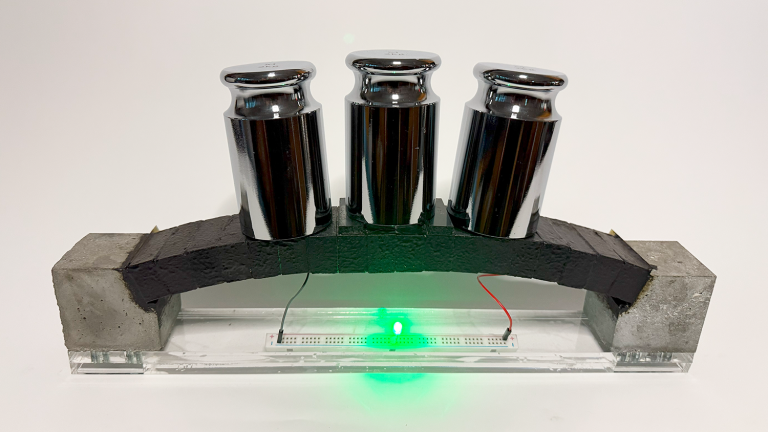
Concrete already builds our world, and now it’s one step closer to powering it, too. Made by combining cement, water, ultra-fine carbon black (with nanoscale particles), and electrolytes, electron-conducting carbon concrete (ec3, pronounced “e-c-cubed”) creates a conductive “nanonetwork” inside concrete that could enable everyday structures like walls, sidewalks, and bridges to store and release electrical energy. In other words, the concrete around us could one day double as giant “batteries.”
As MIT researchers report in a new PNAS paper, optimized electrolytes and manufacturing processes have increased the energy storage capacity of the latest ec3 supercapacitors by an order of magnitude. In 2023, storing enough energy to meet the daily needs of the average home would have required about 45 cubic meters of ec3, roughly the amount of concrete used in a typical basement. Now, with the improved electrolyte, that same task can be achieved with about 5 cubic meters, the volume of a typical basement wall.
“A key to the sustainability of concrete is the development of ‘multifunctional concrete,’ which integrates functionalities like this energy storage, self-healing, and carbon sequestration. Concrete is already the world’s most-used construction material, so why not take advantage of that scale to create other benefits?” asks Admir Masic, lead author of the new study, MIT Electron-Conducting Carbon-Cement-Based Materials Hub (EC³ Hub) co-director, and associate professor of civil and environmental engineering (CEE) at MIT.
The improved energy density was made possible by a deeper understanding of how the nanocarbon black network inside ec3 functions and interacts with electrolytes. Using focused ion beams for the sequential removal of thin layers of the ec3 material, followed by high-resolution imaging of each slice with a scanning electron microscope (a technique called FIB-SEM tomography), the team across the EC³ Hub and MIT Concrete Sustainability Hub was able to reconstruct the conductive nanonetwork at the highest resolution yet. This approach allowed the team to discover that the network is essentially a fractal-like “web” that surrounds ec3 pores, which is what allows the electrolyte to infiltrate and for current to flow through the system.
“Understanding how these materials ‘assemble’ themselves at the nanoscale is key to achieving these new functionalities,” adds Masic.
Equipped with their new understanding of the nanonetwork, the team experimented with different electrolytes and their concentrations to see how they impacted energy storage density. As Damian Stefaniuk, first author and EC³ Hub research scientist, highlights, “we found that there is a wide range of electrolytes that could be viable candidates for ec3. This even includes seawater, which could make this a good material for use in coastal and marine applications, perhaps as support structures for offshore wind farms.”
At the same time, the team streamlined the way they added electrolytes to the mix. Rather than curing ec3 electrodes and then soaking them in electrolyte, they added the electrolyte directly into the mixing water. Since electrolyte penetration was no longer a limitation, the team could cast thicker electrodes that stored more energy.
The team achieved the greatest performance when they switched to organic electrolytes, especially those that combined quaternary ammonium salts — found in everyday products like disinfectants — with acetonitrile, a clear, conductive liquid often used in industry. A cubic meter of this version of ec3 — about the size of a refrigerator — can store over 2 kilowatt-hours of energy. That’s about enough to power an actual refrigerator for a day.
While batteries maintain a higher energy density, ec3 can in principle be incorporated directly into a wide range of architectural elements — from slabs and walls to domes and vaults — and last as long as the structure itself.
“The Ancient Romans made great advances in concrete construction. Massive structures like the Pantheon stand to this day without reinforcement. If we keep up their spirit of combining material science with architectural vision, we could be at the brink of a new architectural revolution with multifunctional concretes like ec3,” proposes Masic.
Taking inspiration from Roman architecture, the team built a miniature ec3 arch to show how structural form and energy storage can work together. Operating at 9 volts, the arch supported its own weight and additional load while powering an LED light.
However, something unique happened when the load on the arch increased: the light flickered. This is likely due to the way stress impacts electrical contacts or the distribution of charges. “There may be a kind of self-monitoring capacity here. If we think of an ec3 arch at architectural scale, its output may fluctuate when it’s impacted by a stressor like high winds. We may be able to use this as a signal of when and to what extent a structure is stressed, or monitor its overall health in real time,” envisions Masic.
The latest developments in ec³ technology bring it a step closer to real-world scalability. It’s already been used to heat sidewalk slabs in Sapporo, Japan, due to its thermally conductive properties, representing a potential alternative to salting. “With these higher energy densities and demonstrated value across a broader application space, we now have a powerful and flexible tool that can help us address a wide range of persistent energy challenges,” explains Stefaniuk. “One of our biggest motivations was to help enable the renewable energy transition. Solar power, for example, has come a long way in terms of efficiency. However, it can only generate power when there’s enough sunlight. So, the question becomes: How do you meet your energy needs at night, or on cloudy days?”
Franz-Josef Ulm, EC³ Hub co-director and CEE professor, continues the thread: “The answer is that you need a way to store and release energy. This has usually meant a battery, which often relies on scarce or harmful materials. We believe that ec3 is a viable substitute, letting our buildings and infrastructure meet our energy storage needs.” The team is working toward applications like parking spaces and roads that could charge electric vehicles, as well as homes that can operate fully off the grid.
“What excites us most is that we’ve taken a material as ancient as concrete and shown that it can do something entirely new,” says James Weaver, a co-author on the paper who is an associate professor of design technology and materials science and engineering at Cornell University, as well as a former EC³ Hub researcher. “By combining modern nanoscience with an ancient building block of civilization, we’re opening a door to infrastructure that doesn’t just support our lives, it powers them.”





